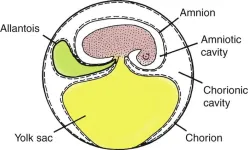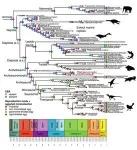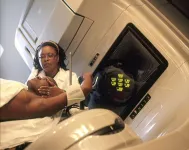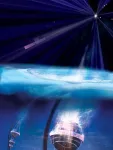(Press-News.org) The earliest reptiles, birds and mammals may have borne live young, researchers from Nanjing University and University of Bristol have revealed.
Until now, the hard-shelled egg was thought to be the key to the success of the amniotes - a group of vertebrates that undergo embryonic or foetal development within an amnion, a protective membrane inside the egg.
However, a fresh study of 51 fossil species and 29 living species which could be categorised as oviparous (laying hard or soft-shelled eggs) or viviparous (giving birth to live young) suggests otherwise.
The findings, published today in Nature Ecology & Evolution, show that all the great evolutionary branches of Amniota, namely Mammalia, Lepidosauria (lizards and relatives), and Archosauria (dinosaurs, crocodilians, birds) reveal viviparity and extended embryo retention in their ancestors.
Extended embryo retention (EER) is when the young are retained by the mother for a varying amount of time, likely depending on when conditions are best for survival.
While the hard-shelled egg has often been seen as one of the greatest innovations in evolution, this research implies it was EER that gave this particular group of animals the ultimate protection.
Professor Michael Benton from the Bristol’s School of Earth Sciences explained: “Before the amniotes, the first tetrapods to evolve limbs from fishy fins were broadly amphibious in habits. They had to live in or near water to feed and breed, as in modern amphibians such as frogs and salamanders.
“When the amniotes came on the scene 320 million years ago, they were able to break away from the water by evolving waterproof skin and other ways to control water loss. But the amniotic egg was the key. It was said to be a ‘private pond’ in which the developing reptile was protected from drying out in the warm climates and enabled the Amniota to move away from the waterside and dominate terrestrial ecosystems.”
Project Leader Professor Baoyu Jiang added: “This standard view has been challenged. Biologists had noticed many lizards and snakes display flexible reproductive strategy across oviparity and viviparity.
“Sometimes, closely related species show both behaviours, and it turns out that live-bearing lizards can flip back to laying eggs much more easily than had been assumed.”
“Also, when we look at fossils, we find that many of them were live-bearers, including the Mesozoic marine reptiles like ichthyosaurs and plesiosaurs,” said Dr Armin Elsler. “Other fossils, including a choristodere from the Cretaceous of China, described here, show the to-and-fro between oviparity and viviparity happened in other groups, not just in lizards.”
Dr Joseph Keating explained: “EER is widespread among vertebrates today, where the developing young are retained by the mother for a lesser or greater span of time.
“EER is common and variable in lizards and snakes today. Their young can be released, either inside an egg or as little wrigglers, at different developmental stages, and there appears to be ecological advantages of EER, perhaps allowing the mothers to release their young when temperatures are warm enough and food supplies are rich.”
Professor Benton concluded: “Our work, and that of many others in recent years, has consigned the classic ‘reptile egg’ model of the textbooks to the wastebasket.
“The first amniotes had evolved extended embryo retention rather than a hard-shelled egg to protect the developing embryo for a lesser or greater amount of time inside the mother, so birth could be delayed until environments become favourable.
“Whether the first amniote babies were born in parchment eggs or as live, snapping little insect-eaters is unknown, but this adaptive parental protection gave them the advantage over spawning earlier tetrapods.”
The paper
‘Extended embryo retention and viviparity in the first amniotes’ by Baoyu Jiang, Yiming He, Armin Elsler, Shengyu Wang, Joseph N. Ke inating, Junyi Song, Stuart L. Kearns and Michael J. Benton in Nature Ecology & Evolution.
link: https://doi.org/10.1038/s41559-023-02074-0
END
Which came first: the reptile or the egg?
2023-06-12
ELSE PRESS RELEASES FROM THIS DATE:
Determining how a sugar molecule can affect cancer cell response to chemoradiotherapy
2023-06-12
WASHINGTON --- Researchers at Georgetown University’s Lombardi Comprehensive Cancer Center and colleagues who have been exploring the complexities of biochemical pathways involved in cancer development have found that a form of glucose, a type of sugar, is intricately linked to a pathway used to build DNA molecules. When this pathway is overactive, it can lead to cancer and resistance to chemoradiotherapy.
The findings appear June 12, 2023, in Nature Chemical Biology.
“For a good while, my lab has been exploring cell signaling and DNA transcription mechanisms by which cellular metabolism changes in response to environmental and genetic cues, with the goal of designing ...
Unhealthy neighborhood food environments are linked to poor birth weight outcomes in New York
2023-06-12
Higher neighborhood density of unhealthy retail food establishments was associated with a higher risk of delivering a baby that was large-for-gestational age, according to a new study at Columbia Mailman School of Public Health, while neighborhoods with a high density of healthy food retail establishments was linked with a lower risk of giving birth to a baby that was small-for-gestational age. Babies born either small- or large-for-gestational age, a measure of birth weight adjusted for length of pregnancy, are at greater risk for long term health complications, but until now little was known about how neighborhood characteristics including walkability and the ...
Astronomers discover supernova explosion through rare ‘cosmic magnifying glasses’
2023-06-12
According to Einstein’s general theory of relativity, time and space are fused together in a quantity known as spacetime. The theory suggests that massive objects, like a galaxy or galaxy clusters, can cause spacetime to curve. Gravitational lensing is a rare yet observable example of Einstein’s theory in action; the mass of a large celestial body can significantly bend light as it travels through spacetime, much like a magnifying lens. When light from a more distant light source passes by this lens, scientists can use the resulting visual distortions to view objects that would otherwise be too far away and too faint to be seen.
An ...
Study brings new understanding of multiple myeloma evolution
2023-06-12
HOUSTON – A new study by researchers at The University of Texas MD Anderson Cancer Center highlights novel insights into the evolution of multiple myeloma from precursor disease, which may help better identify patients likely to progress and develop new interventions.
Published today in Cancer Cell, the study integrates paired single-cell RNA sequencing and B cell receptor sequencing from 64 patients with multiple myeloma or precursor disease. The study achieved several notable milestones in the effort to better understand ...
Previously unknown material could revolutionize cancer treatment
2023-06-12
A new material, created at the little-explored intersection of organic and inorganic chemistry, could not only enable more powerful solar panels, but it could also usher in the next generation of cancer treatments.
Described in a Nature Chemistry journal paper published today, the composite is made of ultra-tiny silicon nanoparticles, and an organic element closely related to those used in OLED televisions. It is capable of increasing the speed with which two molecules can exchange energy, and of converting lower-energy light into higher-energy light.
Only a handful of laboratories ...
19-hour days for a billion years of Earth’s history: Study
2023-06-12
It's tough accomplishing everything we want to get done in a day. But it would have been even more difficult had we lived earlier in Earth's history.
Although we take the 24-hour day for granted, in Earth's deep past, days were even shorter.
Day length was shorter because the Moon was closer. "Over time, the Moon has stolen Earth's rotational energy to boost it into a higher orbit farther from Earth," said Ross Mitchell, geophysicist at the Institute of Geology and Geophysics of the Chinese Academy of Sciences and lead author of a new study published in Nature Geoscience.
"Most models of Earth's rotation predict that day length was consistently shorter ...
New method enables study of nano-sized particles
2023-06-12
Researchers at Karolinska Institutet have created a new method of studying the smallest bioparticles in the body. The study, which is published in Nature Biotechnology, has considerable scientific potential, such as in the development of more effective vaccines.
Circulating around the body are nanoparticles that affect it in one way or another. For example, there are lipoproteins that maintain cell metabolism, pathogenic viruses that cause many diseases and lipid nanoparticles that are used to carry drugs, like recent lipid nanoparticle-based mRNA vaccines.
However, ...
Unveiling quantum gravity: New results from IceCube and Fermi data
2023-06-12
In a study published in Nature Astronomy today, a team of researchers from the University of Naples “Federico II”, the University of Wroclaw, and the University of Bergen examined a quantum-gravity model of particle propagation in which the speed of ultrarelativistic particles decreases with rising energy. This effect is expected to be extremely small, proportional to the ratio between particle energy and the Planck scale, but when observing very distant astrophysical sources, it can accumulate to observable levels. The ...
State agencies grant nationwide access to ultrasound disinfectant from Parker Labs
2023-06-12
FAIRFIELD, NJ—Parker Laboratories Inc. has announced that the environmental protection and pesticide control agencies of all 50 states have authorized registration of Tristel DUO, an intermediate-level disinfecting foam for the cleaning and disinfection of general medical surfaces—including noninvasive ultrasound transducers and their related equipment.
Tristel DUO is manufactured and distributed for US markets by Parker Laboratories under an exclusive commercial partnership with UK-based infection prevention company Tristel plc. Parker Laboratories ...
Researchers: win up to $40K studying effects of lipoprotein(a) on cardiovascular disease, stroke risk
2023-06-12
DALLAS, June 12, 2023 — The American Heart Association, the world’s leading voluntary organization focused on heart and brain health, invites scientific researchers across the globe to compete in a new data challenge to better inform the scientific understanding of how lipoprotein(a) [Lp(a)] levels impact the risk of cardiovascular disease and stroke. The winning project is eligible to receive a $40,000 USD cash prize.
High levels of Lp(a) — a low-density lipoprotein variant containing a protein called apolipoprotein(a) ...









